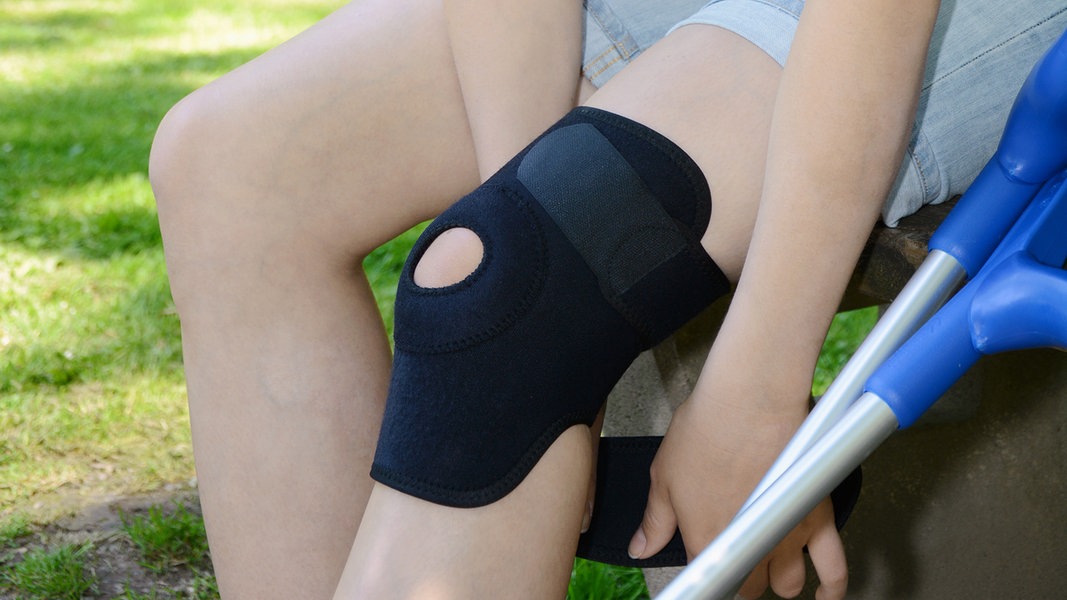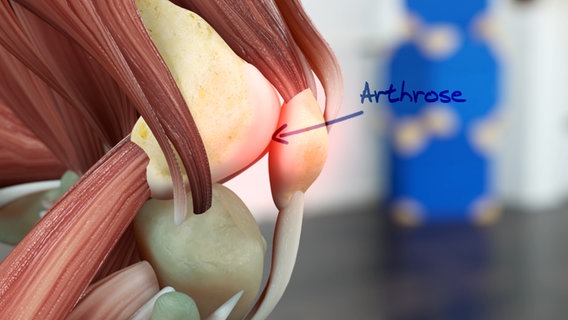Status: 05.06.2023 6:00 p.m
The kneecap (patella) is essential for the protection and function of the knee joint. If it slips, jumps out of its path, wears out or is injured, this causes major problems.
The kneecap (Latin patella) is only a small but very important part of the knee joint: it forms the connection between the upper and lower leg. The slightly curved bony disc at the front, only about two centimeters thick and triangular, lies in front of the actual joint and protects the knee in the front area from external influences. As a movable spacer, it also improves the leverage of the adjacent muscles. A problem-free transfer of force from the thigh to the lower leg is only possible through the kneecap. However, the patella is also quite delicate and particularly prone to injury and fractures.
construction of the knee
The kneecap is held in place by its special shape, but above all by muscles and ligaments.
The kneecap lies in a kind of guide channel in which it can slide back and forth when bending and stretching the entire leg. It is divided into two slightly concave surfaces on the back by a vertical ridge; so it can normally slide optimally in the channel. The patella has a layer of cartilage on its rear surface so that it can slide almost smoothly – at a good six millimeters thick, it is the thickest of all human joints. The patella is surrounded by ligaments: the quadriceps tendon attaches at the top of the thigh muscle, which merges into the patellar ligament at the front and runs below the kneecap as a patellar ligament to the shinbone. Lateral retaining straps (retinaculi) – extensions of the inner and outer thigh muscles – stabilize the kneecap in the middle.
Typical symptoms of kneecap problems
Knee pain when walking down stairs is a typical sign that something is wrong with the kneecap. Those affected cannot squat down well, cannot jog and often have pain even after a walk, especially when going downhill, because the kneecap is painfully pressed into the plain bearing via the thigh muscles. This pain also often feels more like it’s behind the kneecap than deep in the joint.
Kneecap deformity (subluxation): When the patella slips
If the kneecap slips slightly outwards without leaving the leading joint channel, this is referred to as a malposition or subluxation. The deformity causes increased pressure on parts of the kneecap, which can lead to pain and premature wear of the kneecap cartilage.
Further information
Patellar dislocation: When the kneecap jumps out of its place
If the kneecap jumps out of its slideway, this is referred to as a patellar luxation, a kneecap instability. This often leads to injuries to the cartilage and ligaments, such as a tear in the MPFL (medial patella-femoral ligament). The first time the patellar dislocation usually leads to severe pain and a joint blockage. If the dislocated kneecap does not spring back on its own, it must be returned to its plain bearing manually. A luxating patella can occur again and again with the appropriate anatomical predisposition.
Causes of kneecap problems
Multiple factors often contribute to kneecap problems. Patella problems are hereditary in many sufferers. They often start with a growth spurt in adolescence. They are reinforced by a weakly developed musculature – usually the inner thigh muscle (vastus medialis) is not strong enough to control the kneecap.
Kneecap complaints are favored by
- X-legs
- a too flat posterior surface of the kneecap or articular surface of the thigh
- connective tissue weakness
- Kneecap fracture (patella fracture) in an accident
- overweight
- constant running on hard ground
- High-heeled or hard-soled shoes
- Sports with jerky lateral movements
If the patella cannot slide back and forth optimally in its groove, its cartilage layer gradually wears out: Arthrosis develops at the knee joint (retropatellar arthrosis). In addition, the body tries to compensate for the loss of cartilage by growing bones. These ossifications then also get in the way when bending and stretching the knee joint, which increases the symptoms.
Diagnosis of kneecap disorders
A detailed anamnesis of the symptoms and a careful clinical examination are fundamental to the diagnosis. When palpating the knee joint, the doctor feels a slight rubbing on the outside as the knee moves, possibly also rubbing behind the kneecap, a crunching sound, and a snapping sound. If the kneecap is sensitive to pressure and you can feel a slight crunching or cracking, this indicates wear behind the kneecap.
X-rays or magnetic resonance imaging (MRI) provide information about the position of the kneecap and any existing cartilage damage.
The orthopedist can use the isokinet, a force measuring device, to test the strength of the extensor and flexor. The values of the anterior and posterior muscles of the thigh are evaluated in relation to each other. A ratio of 60 percent to 40 percent would be desirable: the extensors should therefore be stronger than the flexors.
Conservative treatment: Manual therapy and specific exercises
An unstable knee must be treated, otherwise the kneecap is subject to increased wear and the pain worsens. As a rule, the first approach is conservative therapy: Although movement does not eliminate wear and tear that may have already occurred, it does alleviate the symptoms and makes the joint resilient again.
- A targeted one advanced training is attempted in the case of a malposition and usually also in the case of a luxated patella. Strengthening the muscles around the knee can pull the kneecap into proper alignment, stopping premature wear and tear on the joint. Particular attention must be paid to the centering of the kneecap. Balance exercises and perception training (proprioception training) are particularly important for stabilization in the knee joint.
- Sometimes the cause of the symptoms lies solely in the front thigh muscle, which is so shortened and tight due to too much sitting that it constantly presses on the kneecap and causes pain. On the other hand, a regular one helps strain the shortened thigh muscles by bending one leg at the knee and pulling the foot with the arm towards the buttocks. Maintain a straight, upright posture and ensure that both thighs are parallel. The stretching exercise also has a preventative effect if the kneecap is not causing any problems.
- In addition, one manual therapy give the patella and the joint more space. This relaxes and relieves the pain.
- An active lifestyle with light exercise such as walking, cycling or – if sufficient stability has been established in the knee through the rehabilitation training – jogging help to keep the cartilage elastic. Healthy diet and regular exercise become more important with age. If you are overweight, losing weight helps to alleviate the symptoms, because every gram less body weight is easier on the joints.
Kneecap surgery
If it is not possible to stabilize the knee in the long term despite conservative therapy, an operation can make sense. In the case of repeated luxating of the patella or a persistent feeling of instability, surgery is often recommended in order to eliminate the anatomical risk factors and to prevent further damage to the cartilage. There are various approaches to surgically stabilizing the knee. For example, the ligaments can be moved so that the patella is better centered, possibly combined with the severing of lateral capsule fibers. Or the surgeon rasps the kneecap into a shape that can run better in the slide channel. Another approach is the Partial prosthesis: Only the kneecap and the groove are replaced with a prosthesis.
Surgery does not replace training
Even if an operation is necessary, the sustainability of the result depends largely on the strength of the leg muscles. Therefore, she should be trained as much as possible before and after the procedure.
experts



